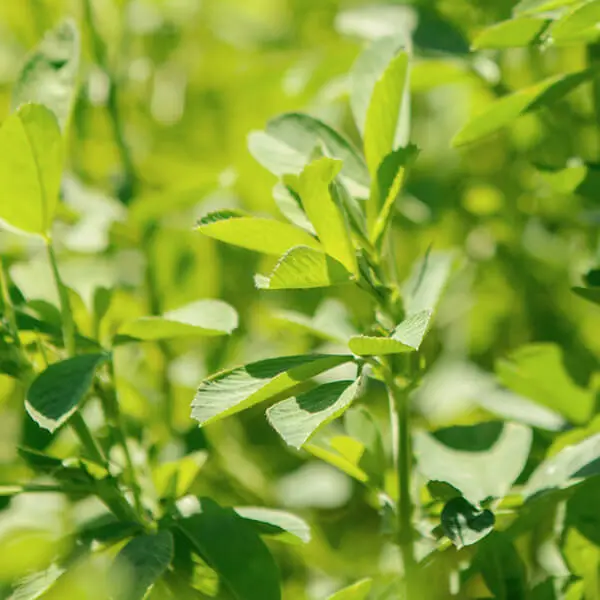WE WILL BE CLOSED ON SATURDAYS THROUGH JANUARY. SORRY FOR ANY INCONVENIENCE.
(800) 352-5247
- Seed Finder
- About
- Resources
- Find a Dealer
- Blue River Organic
- Viking Non-GMO
- Login
WE WILL BE CLOSED ON SATURDAYS THROUGH JANUARY. SORRY FOR ANY INCONVENIENCE.

Price range: $42.50 through $350.00
Browse our lineup of high quality, top yielding, and persistent organic alfalfa varieties available from Blue River organic and Albert Lea Seed. When selecting an alfalfa variety, it’s important to consider how long the field will be in production, how many cuttings a year you plan to take, the end use for the forage (quality needs), and the unique challenges for the field location (disease/insects).
For practical knowledge and friendly advice on which alfalfa varieties to select for your farm, reach out to your local Blue River organic dealer or give us a call 800.352.5247.
| Variety/Brand | W.S.I | FD | # of Cuttings | Traffic Tolerance | Poorly-Drained Soils | D.R.I | Aphanomyces Race 1 | Aphanomyces Race 2 | Aphanomyces Race 2+ | Phyto. Root Rot | Vertic. Root Rot | Bacterial Wilt | Fusarium Wilt | Anthracnose | Stem Nematode | Pea Aphid Tol |
|---|---|---|---|---|---|---|---|---|---|---|---|---|---|---|---|---|
| Organic Blue River 394AP Alfalfa | 1.8 | 4.3 | 4-5 | 4 | 5 | 35/35 | HR | HR | R | HR | HR | HR | HR | HR | ID | ID |
| Organic Blue River 374HD Brand Alfalfa | 1.7 | 4.0 | 4-5 | 4 | 5 | 35/35 | HR | HR | MR | HR | HR | HR | HR | HR | ID | ID |
| Organic Blue River 444LH Alfalfa | 1.8 | 3.9 | 3-4 | 4 | 4 | 30/30 | HR | ID | ID | HR | HR | HR | HR | HR | MR | ID |
| Organic Blue River Bluebird Alfalfa | 2.0 | 5.0 | 3-5 | 4 | 5 | 35/35 | HR | HR | ID | HR | HR | HR | HR | HR | MR | R |
| Organic Blue River 3800 Alfalfa | 2.1 | 4.0 | 3-5 | 4 | 4 | 30/30 | HR | ID | ID | HR | HR | HR | HR | HR | ID | HR |
| Organic Blue River 340M Brand Alfalfa | 2.0 | 3.0 | 3-4 | 3 | 3 | 27/30 | R | ID | ID | R | R | HR | HR | HR | ID | R |
| Organic Matrix Creeping Alfalfa | 2.0 | 2.5 | 2-3 | 5 | 3 | 25/30 | R | ID | Id | R | MR | HR | R | HR | ID | R |
| Organic Hardy Brand Alfalfa | 2.2 | 2.0 | 1-2 | 3 | 2 | 11/30 | S | ID | ID | S | S | MR | R | S | ID | ID |
Uses:
Strengths:
Weaknesses:
Winterhardiness:
Good to excellent depending on variety and fertilization (Potash is essential for increasing winterhardiness and stand survival)
Drought-Tolerance:
Excellent (for established stands)
Wet soil tolerance:
Select varieties with Phytophthora & Aphanomyces resistance
Average Nitrogen Fixation:
100 – 150 lbs N /acre
Forage Yield Range:
3 – 8 DM ton / A (average 2- to 4-cut system)
Relative Forage Quality:
147 – 186 (index value)
Seeds per lb:
200,000 to 220,000
Seeding Rate Alone:
15-20 lbs /acre
Seeding Rate in Mixtures:
15 lbs / acre when mixed with grass
Range of Seeding Dates:
Spring or late summer (April – Mid-May and Aug. 5 – 25th in Southern MN)
Methods of seeding:
Broadcast and drag – Drill ; Rolling or cultipacking helps. Often seeded with a small grain cover crop when planted in the spring. Later summer seedings should be direct seeded to minimize competition.
Best seeding depth:
½ to ¾ Inch
Best Soil types:
Well-drained light soils (loam to sandy loam in texture)
pH tolerances:
6.5 to 7.0
All of our Blue River organic and Viking conventional non-GMO alfalfas may be coated with one of these OMRI-listed inoculants or coatings:
Encapsulates each seed in a mix of micro-nutrients, including iron, zinc, and manganese; and rhizobia bacteria to ensure nodulation and nitrogen fixation. The HydroLoc absorbent compounds hold water around seed, improving germination and seedling survival, especially under adverse conditions.
Contains a multi-strain, crop-specific rhizobium blend to provide maximum nodulation, stand establishment, and yield potential. Helps attract soil moisture to the seed, ensuring quick stand establishment.
Clay-based pre-inoculant improves early seedling vigor through increased root development and excellent nodulation for higher yields. Contains high levels of rhizobia for nitrogen fixation – 100 million viable cells per gram – and Azospirillum bacteria to promote plant growth.
Have you used this product? Let us know what you think.